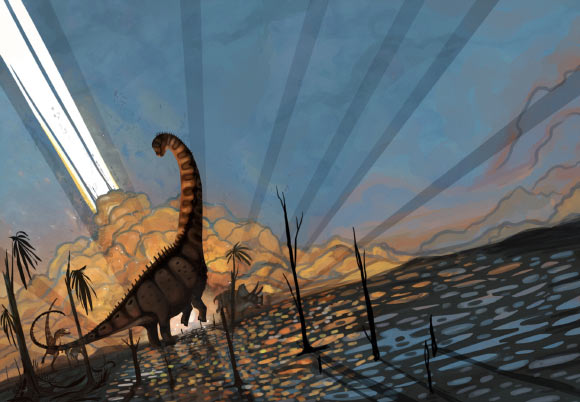The most iconic mass extinction in Earth history occurred around 66 million years ago, as rapid environmental destruction led to the extinction of around 75% of species, most famously the non-avian dinosaurs, and subsequently restructured terrestrial ecosystems. Debate centers on whether dinosaurs vanished abruptly while diverse and flourishing or were in long-term decline before the end-Cretaceous.

Flynn et al. analyzed Alamosaurus fossils found in northwestern New Mexico and discovered these dinosaurs were very different but the same age as dinosaurs found further north in Wyoming and Montana. Image credit: Natalia Jagielska.
In northwestern New Mexico, layers of rock preserve a hidden chapter of Earth’s history.
In the Naashoibito Member of the Kirtland Formation, Baylor University paleontologist Daniel Peppe and his colleagues uncovered evidence of vibrant dinosaur ecosystems that thrived until just before the asteroid impact.
High-precision dating techniques revealed that fossils from these rocks are between 66.4 and 66 million years old.
“The Naashoibito dinosaurs lived at the same time as the famous Hell Creek species in Montana and the Dakotas,” Dr. Peppe said.
“They were not in decline — these were vibrant, diverse communities.”
The New Mexico fossils tell a different story than originally thought.
Far from being uniform and weakened, dinosaur communities across North America were regionally distinct and thriving.
Using ecological and biogeographic analyses, the researchers discovered that dinosaurs in western North America lived in separate bioprovinces, divided not by mountains or rivers, but by temperature differences across regions.
“What our new research shows is that dinosaurs are not on their way out going into the mass extinction,” said New Mexico State University researcher Andrew Flynn.
“They’re doing great, they’re thriving and that the asteroid impact seems to knock them out.”
“This counters a long-held idea that there was this long-term decline in dinosaur diversity leading up to the mass extinction making them more prone to extinction.”
“The asteroid impact ended the age of dinosaurs in an instant — but the ecosystems they left behind set the stage for what came next.”
“Within 300,000 years of their extinction, mammals began to diversify rapidly, exploring new diets, body sizes and ecological roles.”
“The same temperature-driven patterns that shaped dinosaur communities continued into the Paleocene, showing how climate guided life’s rebound after catastrophe.”
“The surviving mammals still retain the same north and south bio provinces.”
“Mammals in the north and the south are very different from each other, which is different than other mass extinctions where it seems to be much more uniform.”
The findings appear today in the journal Science.
_____
Andrew G. Flynn et al. 2025. Late-surviving New Mexican dinosaurs illuminate high end-Cretaceous diversity and provinciality. Science 390 (6771): 400-404; doi: 10.1126/science.adw3282







